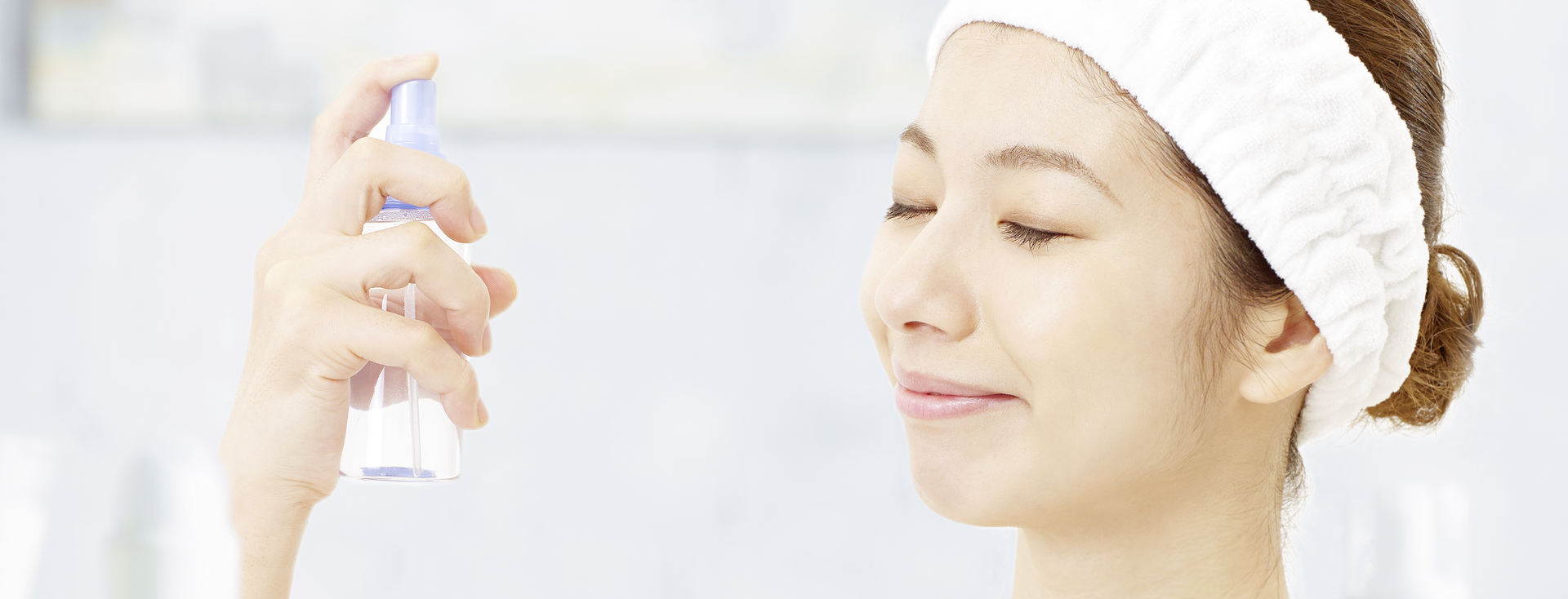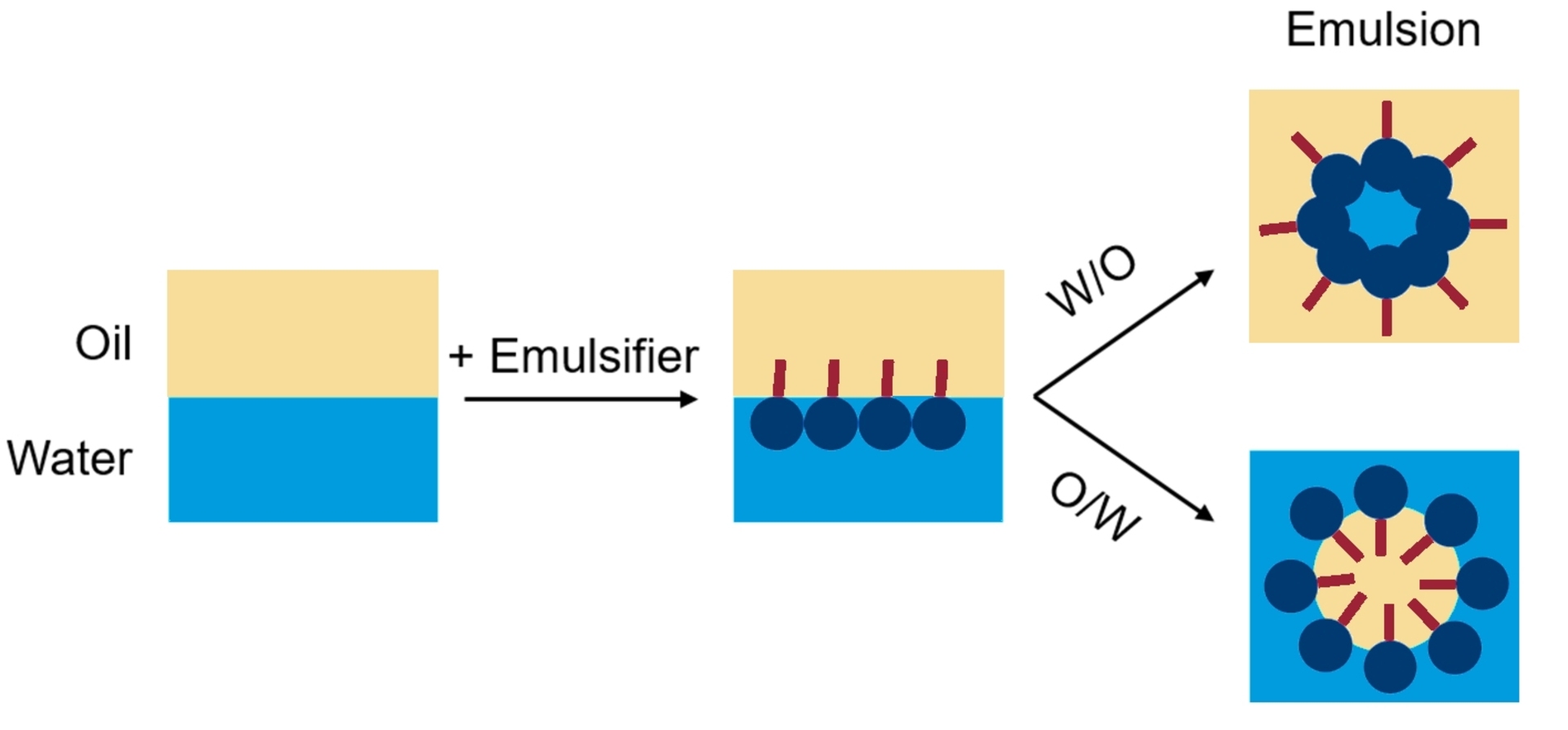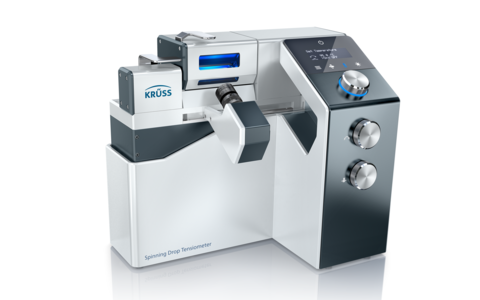
Characterization of a versatile emulsifier for low-viscous formulations and liposomal structures
Interfacial analysis of the surfactant polyglyceryl-10 monooleate as part of a comprehensive product evaluation study
Within the scope of a published study [1] in collaboration with Lonza Ltd. (Basel, Switzerland) and Azelis (Azelis Deutschland Kosmetik GmbH, Moers, Germany), the surfactant polyglyceryl-10 monooleate was tested for its suitability as a skin-compatible emulsifier for low-viscosity sprays and lotions and as a builder for liposomal structures. The aspect of skin compatibility in particular makes it necessary to achieve the desired stabilization of the emulsion with the smallest possible amount of active ingredient. In particular, the number of free surfactant monomers not bound in micelles or liposomes should be as low as possible. Against this background, the determination of the critical micelle concentration (CMC) and the surfactant concentration necessary for the maximum reduction of the interfacial tension between hydrophilic and hydrophobic phase played an important role in the evaluation of the emulsifier.
Here we present the results of our interfacial analytical measurements, which form a section of the broader publication. The complete study includes additional polariation microscopic investigations of the liposomal structure as well as particle size determinations and rheological measurement of complex formulations with polyglyceryl-10 monooleate as emulsifier to evaluate the suitability for finest droplet, low viscosity emulsions.
Background
Emulsions are particularly common in the body care and cosmetics industry, for example in the form of creams or sprays for applying on the skin. An emulsion can be considered as a dispersion of one material inside another non-miscible phase. Typically, in personal care the two phases of an emulsion are called the water and the oil phase.
Emulsions can be used as media to deliver actives to the surface of the skin. But besides being just a vehicle, an emulsion also provides the opportunity to customize the texture and sensory character of the resulting consumer good.
The two types of liquid based emulsions predominant in personal care are:
- W/O Emulsion: Water in Oil, having droplets of water in a continuous oil phase
- O/W Emulsion: Oil in Water, having oil droplets in a continuous aqueous phase

Emulsions do not exhibit spontaneous stability, so the two-phase system will undergo various degenerative processes such as creaming, sedimentation, flocculation, Ostwald ripening, coalescence, and phase inversion. [2] Therefore, high-performance emulsifiers are required to achieve a macroscopic state of stability.
Emulsifiers are surface-active agents (surfactants), which means that they float within the interfaces between aqueous and oily phases and and thus act as mediators - the essential prerequisite for the formation of an emulsion. To what degree an emulsifier is surface active is related to the size of the hydrophilic portion of the molecule as compared to the size of the lipophilic portion. Various emulsifiers or emulsifier systems are available in the market:
- Cationics
- Anionics
- Non-ionics
Anionic emulsifiers, i.e. those with a negatively charged hydrophilic group, are the most commonly used cosmetic emulsifiers, because they are stable and affordable. This class of emulsifiers is the most widely used type of surface-active ingredient for shampoos, because of its excellent cleaning properties and high foaming potential.
Skin tolerance of different types of emulsifiers substances may vary: cationics tend to be more irritating than anionics and anionics more irritating than non-ionics. The issue of irritation is why non-ionic emulsifiers are thepreferred ingredients used in leave-on skin products.
Many commercial non-ionic emulsifiers are based on petrochemicals such as ethylene oxide. However, the consumer trend is away from petrochemical-based ingredients towards naturally derived substances. To meet this new market trend, low-cost, sustainable and versatile bio-emulsifiers are required, which can be used for high-quality, sprayable emulsions and form biocompatible liposomal structures.
As a promising candidate for such a surfactant, we have investigated the active ingredient polyglyceryl-10 monooleate (PG‑10‑1‑O) as an alternative to common emulsifiers on the market.
Experimental part
Samples
Lonza AG's portfolio of personal care emulsifiers includes a variety of products based on raw materials from sustainable palm oil sources (RSPO). The product PG‑10‑1‑O investigated in this study consists of an average of 10 glycerol units linked by ether bonds. This polyglycerol backbone was esterified equivalent with oleic acid based on palm oil.
CMC determination
For the determination of the critical micelle concentration (CMC) in reverse mode (measurement at decreasing concentration) we have measured the surface tension (SFT) of aqueous solutions of PG-10-1-O. The determination was performed fully automatically with a Force Tensiometer - K100 equipped with two Micro Dispensers for dilution between measurements. A total of 90 PG-10-1-O concentrations were measured at a temperature of 25 ±1 °C by successive dilution of the concentrated starting solution.
The measurements were carried out using the Du Noüy ring method, whereby the ring remained immersed in the liquid throughout the entire dilution series. At each concentration, the SFT measurements were repeated until the standard deviation of the running average of the last five measurements was less than 0.1 mN/m. This ensured the measurement of the equilibrium SFT.
Interfacial tension measurements
Three different solutions of PG-10-1-O with 0.25%, 0.5%, and 1.0% in caprylic/capric acid triglyceride (CCGT, "neutral oil") were prepared by stirring and homogenizing in an ultrasonic bath for 15 minutes. The percentage values refer to the mass fraction. CCGT is a vegetable lipid that is well tolerated by the skin and a basic ingredient of many mineral oil and silicone-free body care products.
We determined the interfacial tension (IFT) of these solutions as well as of pure CCTG versus water with the Spinning Drop Tensiometer – SDT at room temperature (24±1 °C). The IFT resulted from an optical Young-Laplace analysis of the curvature of a droplet rotating in a capillary between 6,000 and 15,000 rpm. We also determined the densities of the solutions required as initial parameters for spinning drop measurements using the Force Tensiometer – K100.
Results
Skin irritation can be described as swelling of the skin membrane in response to the binding of surfactants to sites on the stratum corneum (SC). Studies conducted on SC swelling have shown that the rate of swelling decreases after the CMC is reached. This leads to the common opinion that surfactant monomers contribute to skin irritation. In addition, surfactants with a carbon chain length of 8 and 10 (C8 and C10, respectively) have been shown to have higher irritation potentials compared to longer chained surfactant molecules. Increasing the carbon chain length to greater than C8 or C10 decreases the CMC while decreasing the irritation potential to the SC. Therefore, CMC can be used as an orientation aid for the skin irritation potential of surfactants. [3]
In [1] it could be shown that PG-10-1-O does not form micelles at a critical concentration, but double lipid layers similar to a biomembrane, which promotes skin compatibility. Since the effect of this transition on the SFT is the same as in micelle formation, the transition concentration can be determined using a classical CMC measurement. In the following "CMC" refers to the concentration for the specific aggregation behavior of PG-10-1-O.
Fig. 2 shows the SFT of aqueous PG-10-1-O solutions as a function of concentration. The curves show a trend that is also typical for concentration-dependent micelle formation: a linear decrease in SFT over a wide range with increasing concentration up to the CMC point, above which an increase in concentration no longer leads to a further significant decrease in SFT.

We can infer from this data that above a concentration of about 8 to 11 mg/L, it is energetically favorable for the molecules to self-assemble (i.e. to form liposomes) rather than migrating to the water-air interface and thereby no further significant decrease in SFT is observed. Thus, beyond this CMC increasing the bulk concentration does not result in a further increase of the PG-10-1-O monomer concentration at the interface.
A concentration of 10.5 mg/L, which lies in the transition range, corresponds to 0.011 mmol/L at a given molar mass of PG-10-1-O of 1023 g/mol. This concentration is therefore lower than the CMC values of other typical surfactants used in personal care, such as sodium dodecyl sulfate (SDS) with 8.2 mmol/L or C12/14 alkyl polyglycoside with 0.04 mmol/L. [4]
From the slope of the CMC curve it can also be deduced that the surface excess concentration for PG‑10‑1‑O is 1.84·10-12 mol/mm2 and the corresponding space required for a monomer at the surface is 9.010-13 mm2. These values, together with the CMC, indicate that the number of monomers per given surface is lower for PG‑10‑1‑O than for other common surfactants such as those already mentioned – an essential indication of the better mildness of PG‑10‑1‑O. The results of the OFS also indicate good detergency due to low CMC/ST values.
Fig. 3 shows the IFT versus water as a function of the PG‑10‑1‑O concentration in CCTG. Already 0.25% significantly decreases the IFT between water and CCTG from 24 to 0.6 mN/m. A further increase of the PG‑10‑1‑O concentration to up to 1% leads to a slight further reduction of the IFT to 0.2 mN/m. At concentrations above 0.25%, the emulsion performance on the basis of IFT therefore improves only marginally. The IFT already strongly reduced at 0.25% indicates that this low concentration could already be sufficient for a stable and good emulsification.

Summary
For the surfactant polyglyceryl-10 monooleate, measurements of the critical micelle concentration (CMC) and the interfacial tension (IFT) between solutions of the surfactant in capryl/capric acid triglyceride (CCGT) and water were performed. The measurements showed that self-assembly of molecules occurs at a very low molar concentration compared to other common emulsifiers, and that the strong reduction of the surface tension is also expected to have a good cleaning effect. The IFT compared to water is also clearly reduced at 0.25% surfactant in CCGT so that a good emulsifying effect can be assumed. As the skin compatibility tends to be better with a small amount of free surfactant monomers at the interface, the active ingredient offers good conditions for use in the personal care sector.
In the larger context of the study [1] the formation of liposomal structures instead of micelles was shown by means of polarization microscopic images. These structures are optimal for use in personal care due to their similarity to natural biomembranes. Furthermore, the high potential of the surfactant for low-viscosity, sprayable formulations was proven by rheological and particle size investigations as well as successful stability tests.
Bibliography
- [1] Victor Low, Holger Seidel, Thomas Willers, Christoph Kolano, Polyglyceryl-10 Monooleate: Characterization of a versatile emulsifier for low-viscous formulations and liposomal structures. H&PC Today, Vol. 13 (6), November/December 2018, 54-57.
- [2] T. F. Tadros, Rheology of Dispersions, 2010, Wiley-VCH, Weinheim.
- [3] Liquid Detergents, Kuo-Yonn Lai, CRC Press, p. 18, ISBN 9781420027907.
- [4] Nonionic Surfactants: Alkyl Polyglucosides. Surfactant Science Series. Volume 91 Edited by Dieter Balzer (Haltern-Lavesum, Germany) and Harald Lüders (Rohm GmbH, Darmstadt, Germany). Marcel Dekker: New York and Basel, Switzerland. 2000 [1] L.Landau and B. Levich, “Dragging of a liquid by a moving plate” Acta Physicochim. URSS 17, 42 (1942).
As mentioned in this application report, a K100 Force Tensiometer had been used for carrying out some of the measurements. The same measuring methods, only with improved precision and ease of use, can now be performed with the up-to-date Tensíío instrument.

